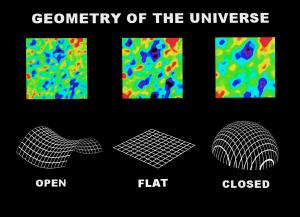Blog
Getting Into Shape
6 November 2019
 Gam Ol via Pexels
Gam Ol via PexelsThe universe is a seemingly endless sea filled with stars, galaxies, and nebulae. In it, we see patterns and constellations that have inspired stories throughout history. But there is one cosmic pattern we still don’t understand. A question that remains unanswered: What is the shape of the universe? We thought we knew, but new research suggests otherwise, and it could point to a crisis in cosmology.
 Library of Congress
Library of CongressMany early astronomers held that the universe was a sphere of stars, enclosing the solar system and centered on a fixed, unmoving Earth. But over the centuries astronomers found that our Sun was merely one of billions within a galaxy, and there were countless galaxies scattered across billions of light-years of space. The question of the shape of creation seemed a moot point. Stars and galaxies existed within empty space. What could space be but a blank canvas: flat, Euclidian, and devoid of structure.
Then in the early 1900s, Albert Einstein developed his theory of general relativity. In it, space was not a blank canvas. It could bend and stretch, twist and deform, based upon the position and motion of mass in the universe. These spatial deformations deflected light and matter, causing the effect we call gravity. With relativity, space could take on different shapes. It was possible then that the universe could have an overall cosmic shape, just as the Earth is, on the whole, round.1
Very broadly, general relativity would allow the universe to have one of three shapes: flat, closed, or open.
 NASA
NASAFlat is the way we think of space in our everyday lives. It is the Euclidean space we learn about in school. Flat space extends evenly in all directions, and two parallel beams of light would forever remain parallel.
Open space can be imagined as saddle-shaped. It bends in such a way that it diverges as you extend outward. Two beams of light initially parallel would gradually spread apart, turning slightly away from each other as they traverse the cosmos.
Closed space is generally spherical. It converges as it extends, so that parallel beams of light would eventually meet and cross each other, like lines of longitude on the Earth.
It should be mentioned that none of these have to deal with the fact that the universe as a whole is expanding. Cosmic expansion means that points in space are spreading apart over time. The shape of the universe deals with the shape of space. A spherical balloon can expand as it is inflated, just as a flat rubber sheet can be stretched and remain flat. So our expanding universe could be flat, open, or closed.
Since the curvature of space is affected by the presence of mass, the overall shape of the universe depends upon the average density of matter within it. In general relativity this value is given by the density parameter Ω0, which is the ratio of observed density to the “critical density” needed for the universe to be flat. If Ω0 is 1, then the universe is flat. If it’s greater than 1 it is closed, and it’s open if Ω0 is less than 1. Measurements of cosmic density have consistently given Ω0 a value of 1. To the limits of observation, the universe is flat, just as long suspected.
 NASA/WMAP Science Team
NASA/WMAP Science TeamBut there is another way to measure the shape of the cosmos, and that is to look at the apparent size of very distant objects. It all comes back to the behavior of parallel beams of light. In a flat universe, parallel lines stay parallel, so light coming from two sides of a distant galaxy reaches us in a straight line. Their angles relative to each other stay the same, and so the galaxy appears as its true size.
If the universe is open, parallel lines diverge with distance. So the light from our distant galaxy becomes more parallel as it reaches us. This means the galaxy would appear smaller than it is. If the universe is closed, the opposite bending of light occurs, and the galaxy would appear larger than it is.
In a new paper published in Nature,2 a team looked not at galaxies, but rather fluctuations within the Cosmic Microwave Background (CMB). The CMB is the remnant light from the big bang, and it is the most distant light we can see in the universe. Because of this, it is the light most affected by the shape of the universe. The scale of fluctuations in the CMB is determined by the amount of dark matter and dark energy in the universe, which we know, so we know how large the fluctuations should appear. When the team analyzed the CMB data from the Plank spacecraft, they found the fluctuations were larger than expected. This means that to within a 99% certainty the universe is closed, not flat.
This new research contradicts numerous previous studies showing the universe is flat. There may be some systematic error in the Planck data that’s making the universe look curved, but if the research is accurate it points to a gap in our understanding. For now, the shape of the universe is unclear.